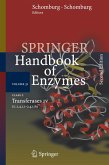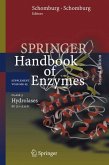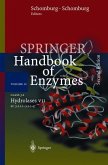The objective of the Enzyme Handbook is to provide in concise form data on enzymes sufficiently well characterized. Data of about 3000 enzymes are presently known and their data sheets will be published. The data sheets are arranged in their EC number sequence, Vol. 13 containing Transferases (Class 2.5 - 2.7.1.104). For each enzyme, systematic and common names are given, information on reaction type, substrate and product spectrum, inhibitors, cofactors, kinetic data, pH and temperature range, origin, purification, molecular data and storage conditions are listed. A reference list completes the data sheets. This collection is an indispensable source of information for researchers applying enzymes in analysis, synthesis and biotechnology.
Today, as the large international genome sequence projects are gaining a great amount of public attention and huge sequence data bases are created it be comes more and more obvious that we are very limited in our ability to access functional data for the gene products - the proteins, in particular for enzymes. Those data are inherently very difficult to collect, interpret and standardize as they are highly distributed among journals from different fields and are often sub ject to experimental conditions. Nevertheless a systematic collection is essential for our interpretation of the genome information and more so for possible appli cations of that knowledge in the fields of medicine, agriculture, etc .. Recent pro gress on enzyme immobilization, enzyme production, enzyme inhibition, coen zyme regeneration and enzyme engineering has opened up fascinating new fields for the potential application of enzymes in a large range of different areas. It is the functional profile of an enzyme that enables a biologist of physician to analyze a metabolic pathway and its disturbance; it is the substrate specificity of an enzyme which tells an analytical biochemist how to design an assay; it is the stability, specificity and efficiency of an enzyme which determines its usefulness in the biotechnical transformation of a molecule. And the sum of all these data will have to be considered when the designer of artificial biocatalysts has to choose the optimum prototype to start with.
Hinweis: Dieser Artikel kann nur an eine deutsche Lieferadresse ausgeliefert werden.
Today, as the large international genome sequence projects are gaining a great amount of public attention and huge sequence data bases are created it be comes more and more obvious that we are very limited in our ability to access functional data for the gene products - the proteins, in particular for enzymes. Those data are inherently very difficult to collect, interpret and standardize as they are highly distributed among journals from different fields and are often sub ject to experimental conditions. Nevertheless a systematic collection is essential for our interpretation of the genome information and more so for possible appli cations of that knowledge in the fields of medicine, agriculture, etc .. Recent pro gress on enzyme immobilization, enzyme production, enzyme inhibition, coen zyme regeneration and enzyme engineering has opened up fascinating new fields for the potential application of enzymes in a large range of different areas. It is the functional profile of an enzyme that enables a biologist of physician to analyze a metabolic pathway and its disturbance; it is the substrate specificity of an enzyme which tells an analytical biochemist how to design an assay; it is the stability, specificity and efficiency of an enzyme which determines its usefulness in the biotechnical transformation of a molecule. And the sum of all these data will have to be considered when the designer of artificial biocatalysts has to choose the optimum prototype to start with.
Hinweis: Dieser Artikel kann nur an eine deutsche Lieferadresse ausgeliefert werden.








